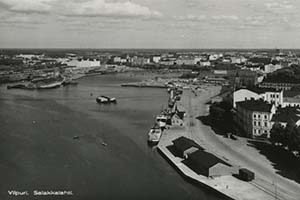From 1918 to 1940, Vyborg and the Port of Vyborg were a part of Finland. Finland was declared independent on December 18, 1918 and the town of Vyborg and its port remained within its borders. In 1926, the Southern and Northern harbours of the port received railway connections. In 1927, quays 5,6,7,8,9 and 10 were built, enabling the port to expand into transshipment of timber, cardboard, paper, grain, bread, coal and coke. In 1931, the town administration of Vyborg made a decision to considerably increase the size and facilities of the South harbour. In 1932 the island of Uuras, where so called Big Harbour was built, became a part of Vyborg. The Port of Vyborg took on the responsibility of developing regional business life. This expansion led to more ambitious goals for the future. At that time Vyborg also functioned as a succesful export port, with timber as the main export cargo shipped from the outer port of Uuras. The expansion project itself began only in 1934. In 1937, the Port of Vyborg became the largest export terminal in Finland and the third largest for imports. In 1937, quays 11, 12 and 13 were built and used primarily for the purpose of transshipping of timber, cardboard, paper, grain, bread, coal and coke. In 1939, the Vyborg harbour was expanded. Also during this year, The Government of Finland had made plans that the Uuras port project should represent the country at the International Fair in Barcelona. For the duration of the Winter War, fought between Finland and the USSR during 1939 and 1940, the seaport of Vyborg was out of operation. |  |